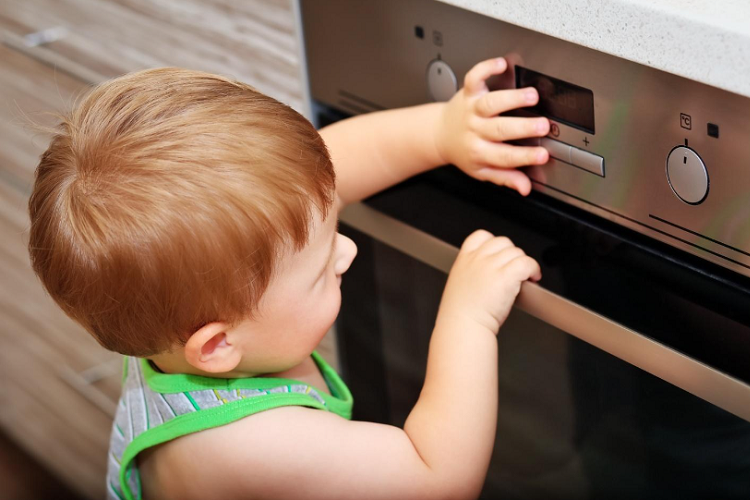Children are filled with the curiosity to study their environment and the unknown. At home, they try to observe every object in every room that they can get their hands on. That means they will try to go to the kitchen.
While a kitchen is an essential part of every home, it’s a place where many accidents can occur with your children. With the presence of many electrical and gas appliances, sharp utensils, and hot objects, children can easily get hurt when they’re left unsupervised.
8 Child Safety Tips in the Kitchen
How can parents safely cook a meal or wash the dishes while their little ones are in the kitchen? Follow these simple precautionary child safety tips in the kitchen to prevent any kind of big mishaps.
Regular Maintenance of Gas Appliances
Many homes have kitchens that use a gas cooking range. With time, this appliance can develop faults if not regularly serviced.
These include gas leaks and carbon monoxide formation (a poisonous gas that doesn’t have a scent, color, or taste). Both are extremely dangerous situations for you and your children. Gas leaks can lead to explosions due to a small spark caused by toggling switches.
Carbon monoxide is a toxic gas that is fatal for humans, especially in higher concentrations. Little concentrations can cause headaches, nausea, and even unconsciousness.
To prevent such circumstances, get your home’s gas appliances checked by a licensed gas safety engineer every year. After verification, you’ll receive a gas safety certificate which verifies that your gas appliances are safe to use.
A gas safety inspection cost depends on the gas safety engineer hired and the number of appliances checked. For example, the cost of gas safety certificates range from £30 to £150.
Take Advantage of Safety Locks
Safety locks can come in handy to prevent children from opening cupboards that contain fragile items or chemicals. You can even use them on fridge doors and ovens so that your toddler won’t be able to access them.
These mini locks come in a variety of designs and features. Some come with hooks or latches that can be easily applied to the handles of cabinet doors without the need of a carpenter. Choose a plastic lock that fits best for the layout of your cupboards.
To keep your child entertained while you cook, you can reserve a cupboard for clean plastic containers so that your child can play with them. That cupboard should be in a spot that requires minimum access to prevent stumbling over your child.
Do supervise your child in between when they’re playing with containers in case they begin to use them for climbing onto countertops.
Keep sharp Objects Out of Reach
Don’t place kitchen knives, scissors, or culinary utensils within drawers that can be easily reached by children. Otherwise, your child may likely end up hurting themself or others badly.
Instead of placing them in reachable cabinets or drawers, place them in upper cupboards. This will make such utensils inaccessible to toddlers.
If you use knife blocks on countertops, it’s advised to keep them far away from edges so that they stay away from hand reach. Otherwise, shift them to upper cabinets.
Don’t Store Cleaning Products in Bottom Cabinets
Do you keep cleaning products under your kitchen sink or in the bottom cabinets? You must relocate the detergents to a place that is safe from the reach of children.
Even if you use safety locks on the bottom cabinets, children make several attempts to figure out how to open one. Once figured out, it can be very easy for your child to enter a cabinet containing chemicals.
These chemicals can easily enter your child’s mouth or eyes and, if they do, can cause poisoning and damage to internal body organs.
To prevent such circumstances, keep cleaning products in upper cabinets or a storage room inaccessible to your child.
Utilize High Chairs or Baby Gates
If you’re cooking a big meal and want your child to sit in one place, use a high chair. You can give your little one some toys or small pieces of food to keep them entertained while you finish your work.
In this way, you can easily use electrical and gas appliances without the worry that your child can fiddle with them.
Another way to keep your children off of kitchen grounds is by using a baby gate in your kitchen entrance. Do keep observing your child in the next room and ask a grown-up family member to look after them while you’re busy in the kitchen.
Shift Food Containers and Medicine into Upper Cupboards
Do you store food containers or medicine in the bottom kitchen cabinets? That’s not an ideal place to keep them, especially when toddlers are around. It’s better to keep them in upper cabinets so that children don’t accidentally eat a drug or choke on a big food piece.
Regularly Clean Kitchen floors
As you know, toddlers love to crawl, sit on the floor, and play. Since the kitchen is where all meals are prepared, it’s a primary spot for bacteria to build up, especially on the floor. That’s why you should have your kitchen floors regularly cleaned.
Use Back Burners on Stoves and Turn Pot Handles Towards the Back
After cooking, don’t keep pot or frypan handles on the edge of the stove facing outwards. This is because children can easily grab those handles and try to pull a utensil down, which can cause serious burns or injuries to the child.
Rather, turn the handles of the pots or frypans inwards if kept on the stove, or place them on the countertops, far away from the edges.
If your gas cooking range has back burners, it’s encouraged to use them for cooking and heating food to keep the front burners cool. Research has shown that cooking on the back burners reduces the amount of pollution by half.
Conclusion
Can parents bring along their children to the kitchen? Yes, they can as long as child safety measures are being taken that prevent accidents.
Keep all kinds of sharp objects in upper cabinets so that they stay out of your children’s reach. Use safety locks to prevent access to cabinets holding fragile items or the fridge. Store medicine and food containers in cabinets or drawers far away from children’s reach.
Dur-e-Sabih provides ghostwriting and copywriting services. Her educational background in Accountancy helps her in tackling topics ranging from career and business productivity to web development, finance, and digital marketing. She writes blog articles for Real Estate CRM.




